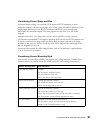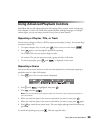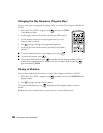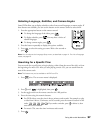
Using MovieMate With Other Equipment 31
Considering Screen Shape and Size
In a home theater setting—for watching DVD movies, HDTV broadcasts, or other
widescreen content—the best screen shape ratio is 16:9, where the width is almost twice the
height. Most DVD movies and HDTV broadcasts will fill the screen vertically and
horizontally for maximum impact. The most popular sizes are from 45 to 100 inches
diagonal.
Standard screens have a 4:3 shape ratio, which is better suited for viewing computer
presentations and standard TV broadcasts. Watching DVD movies or HDTV broadcasts on a
4:3 ratio screen limits the image width and leaves black bars above and below the image.
Available screen sizes vary, but are usually up to 60 inches diagonal (the same height as an
80-inch diagonal 16:9 screen).
Screens are also available for wider image formats, such as CinemaScope
™
(approximately
2.35:1), but are not as common.
Considering Screen Mounting Style
Most screens are either floor standing, wall mounted, or ceiling mounted. Consider these
characteristics as you choose which type would be best for your viewing environment:
Screen mounting style Characteristics
Floor standing screens Portable
Can be used in multiple locations
Can be stored out of the way
Some may also be wall mountable
Wall mounted screens Typically permanently installed
Can be partially hidden out of the way
Some may be disguised as artwork
Ceiling mounted screens Typically permanently installed
Can be partially hidden out of the way
Some may be recessed into the ceiling and hidden completely
Can be manually or electronically dropped and raised
Outdoor screens Resistant to outdoor environmental factors
Can be used on patios, and around pools and landscaping
Usually made of inflatable plastic or vinyl


















